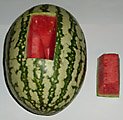Botanically, the fruit belongs to the family of Cucurbitaceae, in the genus: citrullus, and is related to the other same family members such as cantaloupe, squash, and pumpkin that run as vines on the ground surface. It is widely grown across many tropical countries where it is one of the major commercial fruit crops.
Botanical name: Citrullus lanatus.


Watermelon was originated from southern African countries and from where it spread to rest of the tropical and subtropical regions. After a couple of weeks of seedling, plant bears many yellow flowers that may require honeybees for pollination.
Externally, the fruit features smooth, deep green or yellow color thick exterior rind with light-green or gray colored vertical stripes all over its outer surface. Internally, its flesh is juicy, pink, red, or yellow with numerous small black seeds embedded in the middle-third portion of the flesh.
Watermelon has neutral flavor, and its taste somewhat described as plain-sweet water (light sugar syrup). Its flesh is soft yet crunchy unlike soft, creamy texture of muskmelons.
Varieties of watermelon-fruits are cultivated world over, featuring variation in their size, shape, and color of the flesh (red, orange, and yellow).
Health benefits of watermelon
Rich in electrolytes and water content, melons are nature’s gift to beat tropical summer thirst.
Watermelons are very low in calories (just 30 calories per 100 g) and carry minimal fats. Nonetheless, they plentiful in numerous health promoting phyto-nutrients and anti-oxidants essential for optimum health.
Watermelon is an excellent source of Vitamin-A, which is a powerful natural anti-oxidant. 100 g fresh fruit provides 569 mg or 19% of daily-required levels of this vitamin. It is one of essential vitamin for vision and immunity. Vitamin-A is also required for maintaining healthy mucusa and skin. Consumption of natural fruits rich in vitamin-A is known to protect from lung and oral cavity cancers.
It is also rich in anti-oxidant flavonoids like lycopene, beta-carotene, lutein, zeaxanthin and cryptoxanthin. These antioxidants have been found to offer protection against colon, prostate, breast, endometrial, lung, and pancreatic cancers. Phyto-chemicals present in watermelon like lycopene and carotenoids have the ability to help protect cells and other structures in the body from oxygen-free radicals.
Watermelon is an excellent source of carotenoid pigment, lycopene and indeed, superior to raw red tomato. 100 g of fresh melon provides 4532 µg lycopene, whereas this value only 2573 µg for tomatoes. Studies suggest that lycopene offer certain protection to skin against harmful UV rays.
Watermelon fruit is a good source of potassium; Potassium is an important component of cell and body fluids that helps controlling heart rate and blood pressure. It, thus, offers protection against stroke and coronary heart diseases.
Furthermore, it contains a good amount of vitamin-B6 (pyridoxine), thiamin (vitamin B-1), vitamin-C, and manganese. Consumption of foods rich in vitamin-C helps the body develop resistance against infectious agents and scavenge harmful oxygen-free radicals. Manganese is used by the body as a co-factor for the antioxidant enzyme, superoxide dismutase.
Total measured antioxidant strength (ORAC value) of watermelon is 142 µmol TE/100 g.
Selection and storage
Although watermelons can be grown in all the seasons under tropical environments, they are at their best during summer months. In the markets, try to buy organically grown melons since they are richer in taste and nutrients.
Oftentimes, it is difficult to judge ripeness and taste without checking a wedge section of the melon. Look for one that is heavy for its size featuring rind that is relatively smooth, neither overly shiny nor overly dull, without any cuts or bruises on its surface which might have occurred during transportation.
Once at home, place the fruit in cool, well-ventilated place. The cut sections, however, should be kept inside the refrigerator.
Preparation and serving method
Wash the whole melon in cold running water; one can also otherwise wash it with wet cloth to remove any surface dirt and insecticide/fungicide residues.
Depending up on the size that you desire, watermelon can be sliced, cubed, or scooped into balls.
Here are some serving tips:
Fresh watermelon should be eaten as it is, without any additions/seasonings to experience its delicious, natural sweet taste.
Cubes or sections of the melon are a great addition to fruit salad. Top its wedges with cold chocolate cream and relish!
Jam, sorbet, fruit cocktail, and juice are some nutritious and delicious recipes you can make with melons.
The seeds are roasted and eaten as a snack in some Asian countries.
Its rind is used and eaten as a vegetable in some South American countries.
Safety profile
Allergy to watermelon is rare and it can be safely enjoyed by everyone. Its seeds generally discarded but cause no toxicity if ingested accidentally.
0 Response to "Watermelon nutrition facts"
Post a Comment